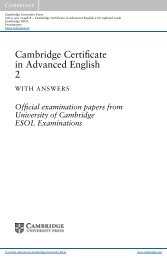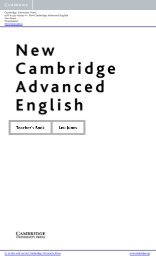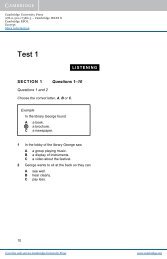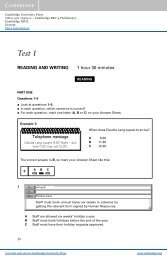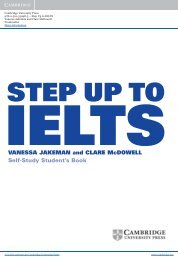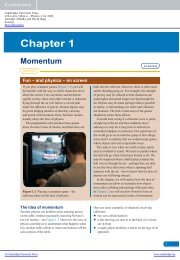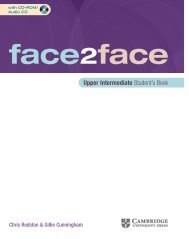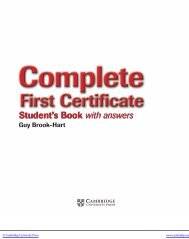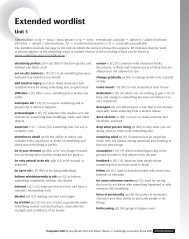Skills for Study Level 2 Teacher's Book - Cambridge University Press
Skills for Study Level 2 Teacher's Book - Cambridge University Press
Skills for Study Level 2 Teacher's Book - Cambridge University Press
You also want an ePaper? Increase the reach of your titles
YUMPU automatically turns print PDFs into web optimized ePapers that Google loves.
2iExample abstractFeatures of the physical environment are known to have effects on the psychologicalstate and cognitive per<strong>for</strong>mance of individuals within them.In the present study, a timed creative problem-solving task was used to determinethe effects of different room decorations on 60 high school students (m=30, f=30).Three room arrangements were set up which were identical in features except one:(1) a basic room with no decorations; (2) potted plants in the room; (3) artworks onthe walls. The participants were randomly assigned to one of the three arrangementsand asked to complete a problem-solving task. After finishing the task, participantscompleted a questionnaire giving their rating of the ‘creativity potential’ of the room.It was found that the female students per<strong>for</strong>med slightly better than males in therooms with any type of decoration. Both male and female students rated rooms withsome sort of decoration as being better <strong>for</strong> creative thinking than those without,though potted plants were preferred by both groups.2j Students swap and analyze their abstracts.3 Avoiding plagiarism – a reviewNote: As SS1 contains an introduction to, and definition of, plagiarism, and all three<strong>Skills</strong> <strong>for</strong> <strong>Study</strong> texts contain sections on paraphrasing, summarizing and quoting,this section is intended to give students a chance to discuss, and hopefully develop,their understanding of the expectations of ‘good’ academic writing. Consequently,there is no actual writing practice in this section, but it is hoped that reflection onthe topic might help students write more effectively in future.3a Student discussion3b Group discussionNote: The aim here is to promote discussion, rather than give categorical rulesabout academic conduct; there<strong>for</strong>e the scenarios are in many cases ambiguous. Asdefinitions of conduct and responses to plagiarism may vary between institutions,no answers are suggested here.3c Class discussion3d Group discussionUnit Task: Designing buildings <strong>for</strong> human needsabStudents use the box to plan out the main body of their report.Students write the full report, with details about word count supplied by theteacher.Note: Ask students to turn to the checklist on p.241 and reread the tips relating toUnit 4 Parts A–D, be<strong>for</strong>e reading the tips to Unit 4 Part E. Encourage students to putthese tips into practice in their studies from now on. Tell them they will be asked toreport back on this in a future lesson.Unit 4 Part E ∙ Reporting in writing 132



